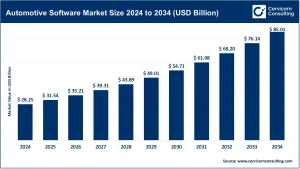Market Overview
The automotive aluminum extrusion market forms a crucial part of the global automotive materials ecosystem, delivering high-precision aluminum profiles used in chassis frameworks, body structures, electric vehicle (EV) battery enclosures, and thermal systems. As of 2024, the market was valued at USD 91.26 billion and is forecasted to reach approximately USD 202.54 billion by 2034, registering a compound annual growth rate (CAGR) of 8.4% between 2025 and 2034.
This growth is primarily attributed to the widespread push for vehicle lightweighting, the accelerating electrification of mobility, and the shift toward sustainable, low-emission materials. With its unique combination of high strength-to-weight ratio, corrosion resistance, and recyclability, aluminum remains a key enabler of next-generation vehicle innovation and sustainable manufacturing practices.
📘 Get a Free Sample: https://www.cervicornconsulting.com/sample/2712
Key Market Trends
1. Surge in Aluminum Utilization for EV Platforms
The ongoing expansion of the EV market has significantly boosted aluminum extrusion usage for battery trays, body frames, crash structures, and roof rails. In 2024, EV applications accounted for nearly 39.3% of the total extrusion demand. Lightweight aluminum designs enhance energy efficiency, range, and crash safety, making it indispensable for modern EV architecture. As global EV adoption intensifies, extrusion demand is expected to scale correspondingly.
2. Advancements in Extrusion and Alloy Innovations
Continuous improvements in hot extrusion, precision shaping, and alloy composition are enabling automakers to design complex, lightweight structures at a lower cost. The introduction of high-strength aluminum alloys allows the substitution of steel in structural and safety-critical components without compromising integrity. These advancements not only optimize vehicle weight but also enhance recyclability and production efficiency.
3. Growing Emphasis on “Green” Aluminum Production
The global push for decarbonization is driving the adoption of low-carbon and recycled aluminum. Leading producers such as Hydro and Alcoa are investing in “green aluminum” initiatives powered by renewable energy and closed-loop recycling systems. This movement aligns with automakers’ broader net-zero emission targets, making sustainable extrusion practices a key competitive differentiator.
4. Regional Manufacturing Expansion
The Asia-Pacific region remains the market leader, accounting for around 41.9% of global revenue in 2024. Rapid industrialization, large-scale EV production, and supportive government policies have led to major investments in new extrusion facilities. Meanwhile, localization trends in North America and Europe are strengthening regional supply chains and minimizing logistical dependencies.
5. Integration of Smart and Automated Manufacturing
Producers are increasingly adopting AI-driven quality control, robotics, and digital monitoring systems to enhance productivity and reduce defects. Automation streamlines extrusion processes, ensuring higher precision, better material utilization, and lower production costs — a key advantage in today’s competitive market landscape.
Market Drivers
1. Tightening Global Emission Standards
Stricter emission and fuel-efficiency mandates across the U.S., EU, China, and Japan are compelling automakers to embrace lightweight materials. Aluminum extrusions play a central role in meeting these regulations, supporting vehicle weight reduction and energy optimization.
2. Accelerating EV Production
With EVs forming nearly 40% of aluminum extrusion demand in 2024, the transition to electric mobility remains the strongest driver. Lightweight aluminum structures are vital to improving EV battery performance and driving efficiency.
3. Structural and Chassis Applications Dominating Demand
Structural components and chassis systems contributed 44.6% of the market share in 2024. The metal’s ability to absorb crash energy while reducing mass enhances safety and performance, prompting broader adoption in both EVs and traditional ICE vehicles.
4. Circular Economy and Recyclability Push
Aluminum recycling uses up to 95% less energy than primary production, making it a cornerstone of circular manufacturing. Automakers are increasingly implementing closed-loop recycling systems that reintegrate aluminum scrap into production, promoting cost efficiency and sustainability.
5. Policy and Regional Investment Support
Government-backed programs promoting EV adoption, local sourcing, and sustainable manufacturing are spurring fresh investments in extrusion capacity. Asia-Pacific nations — notably China, India, and Southeast Asia — are leading this expansion, complemented by the EU Green Deal and North America’s “Build America” initiatives that prioritize local production ecosystems.
Impact of Trends and Drivers
-
By Vehicle Type: EVs account for the largest share of aluminum extrusion demand, with applications concentrated in battery enclosures, body frames, and safety structures.
-
By Component: Chassis and structural parts remain dominant, followed by thermal management and body-in-white systems.
-
By Region:
-
Asia-Pacific leads due to large-scale automotive production and EV subsidies.
-
Europe follows, driven by emission reduction targets and sustainability initiatives.
-
North America shows rising demand as automakers regionalize supply chains.
-
-
By Supply Chain Strategy: OEMs increasingly co-develop extrusion solutions with suppliers, optimizing design, performance, and cost efficiency.
Challenges and Opportunities
Challenges:
-
High energy costs associated with primary aluminum production.
-
Complex multi-material joining techniques required for hybrid vehicle structures.
-
Price volatility in raw aluminum markets.
-
Insufficient recycling infrastructure in emerging economies.
Opportunities:
-
Rapid EV manufacturing expansion globally.
-
Rising adoption of recycled and certified low-carbon aluminum.
-
Technological advancements in automation and AI-based extrusion processes.
-
Regional manufacturing growth enhancing supply chain resilience.
Future Outlook
The automotive aluminum extrusion market is projected to grow from USD 91.26 billion in 2024 to USD 202.54 billion by 2034, at a CAGR of approximately 8.4%.
Over the coming decade, market progress will be shaped by the convergence of lightweighting strategies, sustainable production, and EV innovation. As regulatory pressures and electrification intensify, demand for low-carbon aluminum and advanced extrusion technologies will soar. Companies that invest in digitalized, eco-efficient production and strategic OEM alliances will secure leading market positions.
Ultimately, aluminum extrusions will remain integral to the future of automotive engineering, driving safer, lighter, and more environmentally responsible vehicle manufacturing worldwide.
📞 For a detailed market overview, contact us at: https://www.cervicornconsulting.com/contact-us

